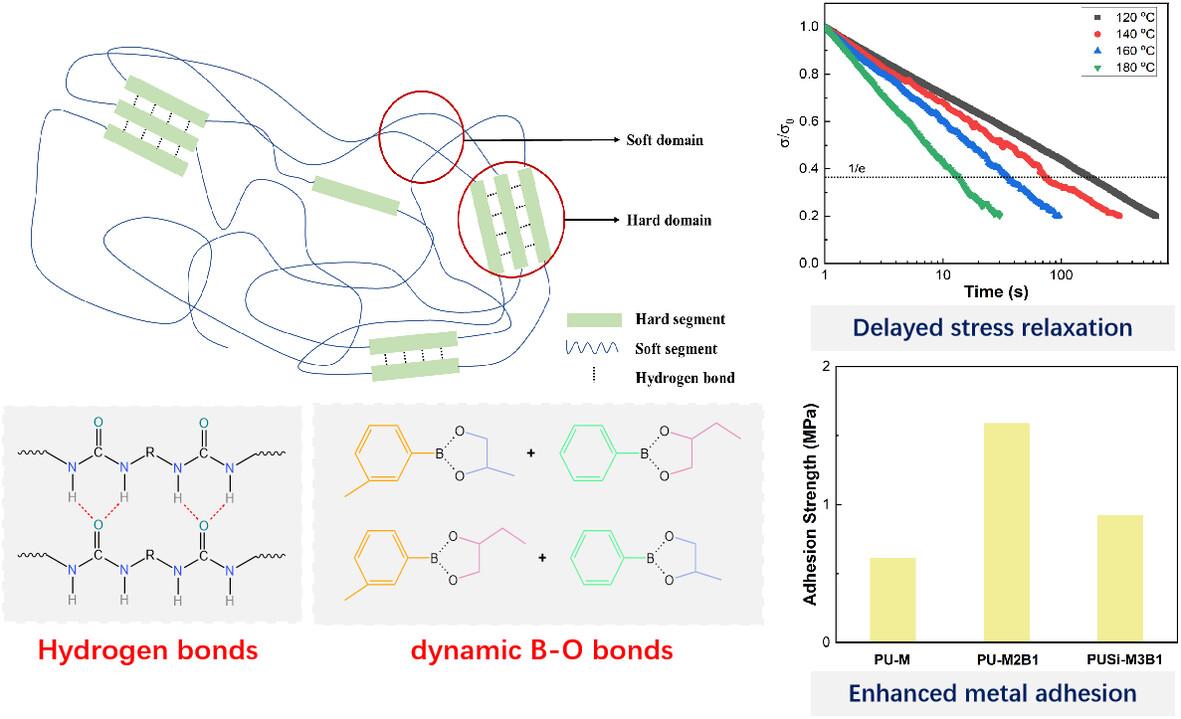Shilong Zhang, Youhao Xiong, Yangwei Wang, Yuqi Ma, Jialiang Li, Chaobo Jiang, Ce Wang, Yanling Zhu, Yongsheng Zhao, Guangcheng Zhang
求助PDF
{"title":"含硅聚脲弹性体具有主链硼氧键,可延迟应力松弛并改善粘合性能","authors":"Shilong Zhang, Youhao Xiong, Yangwei Wang, Yuqi Ma, Jialiang Li, Chaobo Jiang, Ce Wang, Yanling Zhu, Yongsheng Zhao, Guangcheng Zhang","doi":"10.1002/pi.6671","DOIUrl":null,"url":null,"abstract":"<p>Polyurea (PU) elastomers have attracted considerable attention in the field of protective polymeric coatings. In this work, a dithiol-terminated boronic ester was synthesized and used to incorporate dynamic boron–oxygen (B–O) bonds in the PU main chain based on thiol isocyanate while amino-terminated polydimethylsiloxane (PDMS) was introduced to retain good chain flexibility. The modified PU elastomer was found to have a microphase-separated structure in which the hard blocks served as physical crosslinks. The glass transition temperature (<i>T</i><sub>g</sub>) slightly increases when dynamic B–O bonds exist while further introduction of PDMS soft segment can lower <i>T</i><sub>g</sub> to −55.63 °C. The introduction of dynamic B–O bonds and diminished hydrogen bonding led to a decrease in mechanical strength and elongation at break. Interestingly, the simultaneous incorporation of PDMS and dynamic B–O bonds is favorable for strain rate dependence and suppressing stress relaxation. The potential for bond-exchange interactions between the dynamic B–O bonds and hydroxyl groups on metal surfaces substantially improved the adhesion of the PU elastomer to metal substrates. Therefore, our work can offer valuable insights for the structural design of functional PU coatings tailored for anti-impact applications. © 2024 Society of Chemical Industry.</p>","PeriodicalId":20404,"journal":{"name":"Polymer International","volume":"73 10","pages":"874-882"},"PeriodicalIF":3.6000,"publicationDate":"2024-06-21","publicationTypes":"Journal Article","fieldsOfStudy":null,"isOpenAccess":false,"openAccessPdf":"","citationCount":"0","resultStr":"{\"title\":\"Silicone-containing polyurea elastomer possessing main-chain boron–oxygen bonds with delayed stress relaxation and improved adhesive properties\",\"authors\":\"Shilong Zhang, Youhao Xiong, Yangwei Wang, Yuqi Ma, Jialiang Li, Chaobo Jiang, Ce Wang, Yanling Zhu, Yongsheng Zhao, Guangcheng Zhang\",\"doi\":\"10.1002/pi.6671\",\"DOIUrl\":null,\"url\":null,\"abstract\":\"<p>Polyurea (PU) elastomers have attracted considerable attention in the field of protective polymeric coatings. In this work, a dithiol-terminated boronic ester was synthesized and used to incorporate dynamic boron–oxygen (B–O) bonds in the PU main chain based on thiol isocyanate while amino-terminated polydimethylsiloxane (PDMS) was introduced to retain good chain flexibility. The modified PU elastomer was found to have a microphase-separated structure in which the hard blocks served as physical crosslinks. The glass transition temperature (<i>T</i><sub>g</sub>) slightly increases when dynamic B–O bonds exist while further introduction of PDMS soft segment can lower <i>T</i><sub>g</sub> to −55.63 °C. The introduction of dynamic B–O bonds and diminished hydrogen bonding led to a decrease in mechanical strength and elongation at break. Interestingly, the simultaneous incorporation of PDMS and dynamic B–O bonds is favorable for strain rate dependence and suppressing stress relaxation. The potential for bond-exchange interactions between the dynamic B–O bonds and hydroxyl groups on metal surfaces substantially improved the adhesion of the PU elastomer to metal substrates. Therefore, our work can offer valuable insights for the structural design of functional PU coatings tailored for anti-impact applications. © 2024 Society of Chemical Industry.</p>\",\"PeriodicalId\":20404,\"journal\":{\"name\":\"Polymer International\",\"volume\":\"73 10\",\"pages\":\"874-882\"},\"PeriodicalIF\":3.6000,\"publicationDate\":\"2024-06-21\",\"publicationTypes\":\"Journal Article\",\"fieldsOfStudy\":null,\"isOpenAccess\":false,\"openAccessPdf\":\"\",\"citationCount\":\"0\",\"resultStr\":null,\"platform\":\"Semanticscholar\",\"paperid\":null,\"PeriodicalName\":\"Polymer International\",\"FirstCategoryId\":\"92\",\"ListUrlMain\":\"https://onlinelibrary.wiley.com/doi/10.1002/pi.6671\",\"RegionNum\":4,\"RegionCategory\":\"化学\",\"ArticlePicture\":[],\"TitleCN\":null,\"AbstractTextCN\":null,\"PMCID\":null,\"EPubDate\":\"\",\"PubModel\":\"\",\"JCR\":\"Q2\",\"JCRName\":\"POLYMER SCIENCE\",\"Score\":null,\"Total\":0}","platform":"Semanticscholar","paperid":null,"PeriodicalName":"Polymer International","FirstCategoryId":"92","ListUrlMain":"https://onlinelibrary.wiley.com/doi/10.1002/pi.6671","RegionNum":4,"RegionCategory":"化学","ArticlePicture":[],"TitleCN":null,"AbstractTextCN":null,"PMCID":null,"EPubDate":"","PubModel":"","JCR":"Q2","JCRName":"POLYMER SCIENCE","Score":null,"Total":0}
引用次数: 0
引用
批量引用


 求助内容:
求助内容: 应助结果提醒方式:
应助结果提醒方式:


